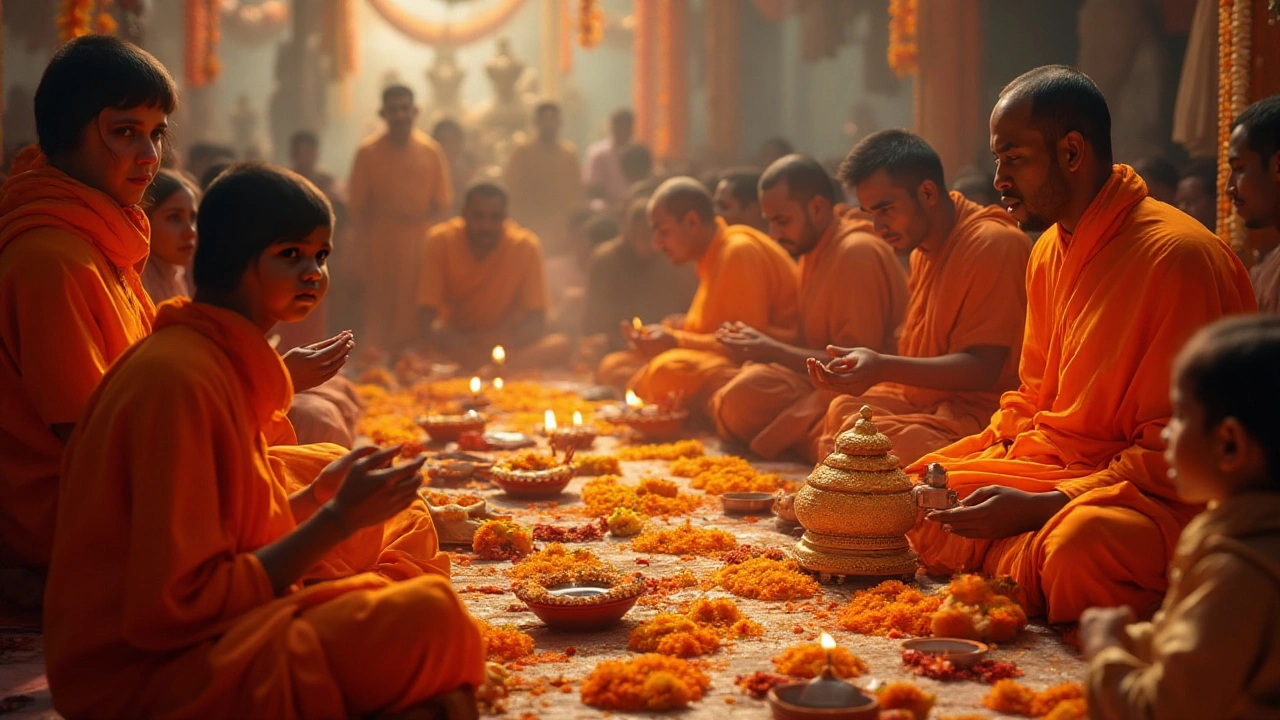Navigating a Hindu Temple Visit Respectfully: A Guide for Travelers

In the heart of India, Hindu temples stand as architectural marvels and sacred places of worship. Each one offers a unique glimpse into a spiritual universe steeped in mythology and tradition. Whether it's your first visit or you're a seasoned traveler, understanding how to respectfully approach these temples can greatly enhance your experience.
Hindu temples are known for their vibrant festivals, intricate sculptures, and deeply rooted rituals. However, they also follow a strict code of conduct that visitors should observe to maintain the sanctity of the environment. This involves dressing appropriately, following temple protocols, and participating in rituals with genuine interest and respect.
As you step into these spaces of faith, knowing what to expect and how to behave helps you connect more deeply with the spiritual atmosphere. This guide is designed to equip you with the essential knowledge needed for a respectful and enriching temple visit, ensuring that your journey through India is both enlightening and memorable.
- Understanding the Significance of Hindu Temples
- Dress Code and Personal Attire
- Temple Customs and Rituals
- Offering and Interactions
- Respectful Conduct Inside the Temple
Understanding the Significance of Hindu Temples
Hindu temples are not just buildings; they are centers of spirituality and cultural heritage that have stood the test of centuries. They serve as a bridge between the human and the divine, creating a space where devotees can meditate, worship, and seek blessings. Each Hindu temple is unique, often dedicated to a specific deity, and plays a significant role in the religious life of its community. Visually stunning, these temples are adorned with intricate carvings and artistic sculptures that depict stories from sacred texts like the Ramayana and Mahabharata. These depictions are not mere decorations; they represent the philosophical beliefs, values, and history of Hinduism, offering insight into the mythology and customs that have shaped Indian culture.
The architecture of Hindu temples follows an ancient set of design principles called Vastu Shastra, which aligns the structure with cosmic forces, facilitating a spiritual experience within its walls. Central to the temple is the 'Garbha Griha' or the inner sanctum where the deity resides. This is considered the most sacred part of the temple, reflecting the spiritual heart. Interestingly, the designs are often meticulously planned to create an awe-inspiring path that leads devotees towards this sanctum. Architecturally, the temple is designed to symbolize various elements of the cosmos, making it a microcosm of the universe itself. What makes Hindu temples particularly fascinating is the way they incorporate elements of art, science, mythology, and spirituality, all neatly woven together to bring a sense of divinity into the daily life of devotees.
"Temples are a testimony to the intricate blend of artistry and worship, reflecting the eternal spiritual quest of mankind," states renowned historian R. Nagaswamy.
A visit to a Hindu temple often includes participation in various rituals and ceremonies, widely considered essential for spiritual progress. These might include offerings (puja) to the deities, chanting of prayers or mantras, and festivals that celebrate various aspects of the divine. Participation in these customs, even as an observer, offers profound insights into the deeply ingrained spiritual practices of the Hindu faith. Each sound, smell, and sight within the temple is purposefully created to enhance the divine experience. As the fragrance of incense hugs the air and the rhythmic chants vibrate through, the atmosphere within a temple deeply resonates with an energy that has been cultivated over millennia.
In addition, Hindu temples are lively centers of social and cultural activity, especially during festivals when communities gather to celebrate auspicious occasions. Festivals like Diwali, Navaratri, and Pongal are marked by vibrant decorations, traditional music and dance performances, and elaborate feasts, turning the temple courtyard into a bustling hive of joy and devotion. These events do not just mark calendars; they foster a sense of community and continuity, serving both spiritual and social purposes. The temple becomes a place of reflection and rejuvenation, not just for individuals but for entire communities. This dual role of the temple as a spiritual and social hub ensures its position as a vital component of life in India.
To truly appreciate a temple, one must also understand its historical context. Many temples in India are centuries old and have seen the rise and fall of empires. They are structures that have borne witness to history, surviving invasions and renovations, often with fascinating stories etched into their very stones. A notable example is the Brihadeeswarar Temple in Tamil Nadu, a UNESCO World Heritage site, famous for its grandeur and historical significance. This temple, completed in 1010 AD by the Chola dynasty, remains one of the greatest examples of Tamil architecture. Such historical and cultural richness makes visiting Hindu temples an enlightening experience, providing a window into the vibrant history of a nation intertwined with spiritual exploration.
Dress Code and Personal Attire
Stepping into a Hindu temple demands a sense of reverence and respect, beginning with the attire you choose. Clothing is not just fabric; it’s a gesture, a signal to the community that you honor their traditions. Respectful dressing takes precedence as it mirrors your understanding and appreciation for the cultural tapestry you’re about to engage with. For men, this often means wearing a dhoti or loose-fitting trousers with a kurta, while women might opt for a sari or a salwar kameez. Regardless of gender, clothes should cover the shoulders and knees; skimpy or tight clothing is discouraged. This practice is not just about modesty but about detaching from materialism, aligning one's thoughts to spiritual awareness.
Temples across the vast subcontinent may have slight variations in dress code norms due to climatic or regional differences, but they share a common thread of requesting visitors to cover their heads as a sign of humility—something often facilitated by a scarf or a shawl. To immerse yourself fully, it may help to embrace local styles and fabrics, which are often comfortable and well-suited to the surroundings. In particular, the scorching Indian summer can be combated with airy, light-colored clothing made from breathable material like cotton.
"In Hindu culture, the temple is a soul's gateway to divine consciousness," says Ranjit Kumar, a renowned cultural historian. "What we wear speaks volumes about our readiness to receive that consciousness, it's an unspoken dialogue with the divine."Upon entering the temple precinct, it's customary for visitors to remove their shoes. This simple act signifies purification and respect for the sacredness of the ground. Many temples provide racks for shoes or encourage visitors to carry a bag to store their footwear safely. Some focus on purity extends to accessories; it's wise to either remove leather items like belts or wallets where relevant, as animal products often clash with spiritual principles.
There's also an unspoken etiquette involved with jewelry, especially as sound travels easily across a temple's stone corridors and quiet reverberates meaningfully. Flashy or noisy accessories might distract other devotees or disrupt the solemnity of prayer, so it's considered best to keep these to a minimum. Essentially, the aim is to ensure that your focus remains on the spiritual experience, not on physical adornments.
In summary, adhering to these dress codes helps foster a respectful atmosphere and ensures that you, along with other visitors, can keep the focus on the overwhelming beauty and sanctity of the experience. It's not uncommon to find signage or temple volunteers willing to guide foreign visitors who might have questions about proper attire. Remembering that these guidelines are steeped in centuries of tradition allows for a deeper appreciation and enables a meaningful exchange, both spiritually and culturally.

Temple Customs and Rituals
Visiting a Hindu temple is more than just a simple walk through an architectural site; it's a journey into a world where spirituality, culture, and history intertwine vividly. As you enter these sacred places, you'll notice the rhythmic chanting of mantras and the mystical scent of incense filling the air. These elements aren't just atmospheric; they are integral parts of temple rituals that have been practiced for millennia. Rituals are often scheduled around specific times of the day, aligned with traditional beliefs about the best moments for worship. Participating or observing these rituals gives you insight into the devout practices that worshippers hold dearly.
One of the first customs you'll encounter in a Hindu temple is the removal of your footwear before entering the sacred space. This act symbolizes humility and respect for the divinity of the place. Additionally, visitors often wash their hands and feet at the entrance, a gesture that signifies purity and readiness to receive spiritual blessings. Inside, you'll find intricate idols and statues of deities, each dedicated to different aspects of life and spirituality. Offerings of flowers, fruits, and even small monetary donations are common, symbolizing gratitude and devotion. Observers might see devotees circumambulating the main shrine, a clockwise walk that represents their reverence and faith.
The aarti is one of the most iconic rituals performed in many Hindu temples. This ceremony involves offering light from wicks soaked in ghee or camphor to the deities, accompanied by the melodic sound of bells and the chanting of hymns. Aarti is not only a way of showing devotion but also a means of purifying the devotees who partake in it. It is said that the light used during aarti absorbs the energy and blessings of the deities, which are then passed on to the attendees.
"The simple act of participating in the aarti, of witnessing this dance of light and sound, helps one connect with the larger cosmos," said Dr. Sandhya Sarin, a noted scholar of Indian spirituality.Visitors are usually encouraged to receive the light with cupped hands and guide it to their forehead as a symbol of acceptance of divine energy.
Different temples may have unique rituals based on the deity they honor. For instance, in temples dedicated to Shiva, one might observe the pouring of milk, water, and honey over the Shiva Lingam — a ritual called Abhishekam. This practice is believed to purify and please the deity, invoking blessings for health and prosperity. Similarly, in Vaishnavite temples dedicated to Vishnu, priests often present offerings of traditional sweets and rice dishes as part of the divine feast for the deity, reflecting hospitality and devotion.
Respectful silence and mindfulness play an essential role during these rituals. It’s respectful to speak in hushed tones and keep cell phones switched off or on silent mode, ensuring the serenity of the worship space remains undisturbed. Asking questions may be appropriate during guided temple tours, but during prayer sessions, it’s better to absorb the experience fully and reflect inwardly. To blend in with the crowd, mimic the body language of the devotees, whether it's folding your palms in prayer or gentle bowing, showing your willingness to respectfully engage with the customs can enhance your temple visit.
Offering and Interactions
Stepping into a Hindu temple is akin to entering a world where the past and present seamlessly blend. Offering and interaction are key components of any temple visit, encompassing both observance and participation. As you immerse yourself in the dynamic hum of devotion, you will find that offerings range from flowers and fruits to modest monetary donations. These offerings hold symbolic meaning, often representing gratitude or a wish for divine blessings. It's customary to present these with both hands, signifying sincerity and a desire to be part of the spiritual communion.
The significance of making an offering is deeply rooted in the Vedic traditions of India. Offering something to the deity is not merely a religious act, but a gesture of goodwill, illustrating the reciprocation between the devotee and the divine. Many temples have designated areas where visitors can hand over their offerings, typically near the entrance or altar. Engaging respectfully with temple staff, priests, or dedicated volunteers ensures your contributions are offered appropriately. Often, temples will lay out guidelines on what is permissible to offer, and inquiring about these specifics showcases your respect for local customs.
Interactions within temple etiquette are governed by a respectful acknowledgment of the shared sacred ambiance. While engaging with priests, it is often appropriate to stand with your hands folded as a sign of reverence. This practice, known as 'Namaste', is more than a simple greeting and conveys your respect towards the person you address. Additionally, some temples allow visitors to partake in rituals or chants; participating with humility and attentiveness pays homage to the age-old traditions that continue to thrive within these walls.
"The true essence of worship lies not in the grandeur of the offering, but in the sincerity of the heart," as Mahatma Gandhi once elucidated.
In many temple settings, communal offerings, such as lighting ceremonial lamps or candles, are a shared expression of devotion. If you choose to light a lamp, do so carefully and with the mindset that you are carrying a light within the timeless tapestry of spirituality. It’s pivotal to observe the flow of temple activities and align your interactions to the rhythm of the surrounding environment. Notably, temple kitchens—often referred to as 'langar' or 'prasad halls'—may offer meals or blessed food, known as 'prasad'. These interactions are not just about receiving sustenance, but sharing in a tradition that transcends the individual, emphasizing unity and community.
The experience of offering and interacting in a temple is as much about receiving as it is giving, creating a circular exchange of compassion and faith. The poised vibrations of ancient chants, the collective reverberation of bells, and the infused aroma of incense create a sanctified atmosphere, encouraging introspection and serenity. As you navigate this matrix, consider each offering and interaction as a learning moment, a step deeper into appreciating the rich spiritual narrative that weaves through India’s cultural fabric.

Respectful Conduct Inside the Temple
A visit to a Hindu temple offers a unique opportunity to delve into India's rich cultural and religious heritage, but it requires visitors to engage thoughtfully and respectfully with the sacred space. The atmosphere inside a temple is often filled with a palpable sense of devotion, with the faint aroma of incense blending harmoniously with the low hum of prayers. As you enter, it's important to understand that this is a place many come seeking peace and connection with the divine. Therefore, maintaining a quiet and respectful demeanor is paramount. Avoid raising your voice or engaging in loud conversations, as this could disrupt the spiritual atmosphere.
The act of removing shoes before entering the temple premises is not just a matter of tradition but a gesture of respect towards the deities revered within. This simple action is deeply rooted in the belief that the removal of shoes symbolizes the shedding of one’s ego and earthly ties. Once inside, it's essential to move slowly and deliberately. There may be designated areas for worship and prayer; take note of these spaces and observe where fellow worshippers congregate.
Photography can be another area where respect needs to be exercised. While modern technology allows us to capture beautiful images, it's crucial to remember that temple etiquette often prohibits photography inside certain areas, particularly sanctums where deities are enshrined. Always seek permission before taking photographs, and even when allowed, ensure that you do not disturb worshippers around you. As the International Journal of Cultural Studies notes, "Tourists' respect for cultural boundaries enriches their travel experience," highlighting the importance of respecting local practices.
"To truly appreciate the spirituality entwined in temple architecture and ritual, one must embrace the customs with an open heart," states cultural historian Dr. Meera Iyer.
Interaction with the temple priests and devotees should be approached with humility and respect. Many priests perform daily rituals and maintain the temple's spiritual upkeep. If you wish to learn more about the proceedings or the temple’s history, approach them after rituals are complete and at a time that seems appropriate. The devotees, too, are generally willing to share their insights if approached courteously. Participating in rituals, such as lighting incense or offering flowers, should be done thoughtfully. Follow any provided instructions and ensure that your actions align with the temple’s prescribed customs.
Some temples have donation boxes to support their upkeep or charitable activities. If you're inclined to contribute, this gesture is often appreciated. However, it's not mandatory, and you should never feel pressured to offer more than what you’re comfortable with. Occasionally, temples organize free meals, known as "prasadam.", which you are welcome to partake in. Being mindful of how you receive and consume it can enhance your experience. Accept the offering with your right hand and treat it with reverence, savoring each bite as part of the spiritual journey.
The essence of visiting a Hindu temple lies in the opportunity to connect with a culture that seamlessly blends daily life with spirituality. By observing the respectful conduct expected inside the temple, visitors can honor the faith and traditions that have flourished for centuries. Such an approach not only enriches one's personal experience but also ensures that the sanctity of these sacred spaces is preserved for future generations to experience and cherish.